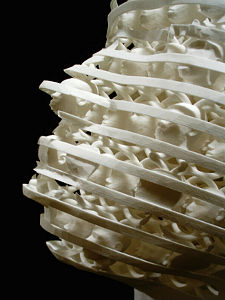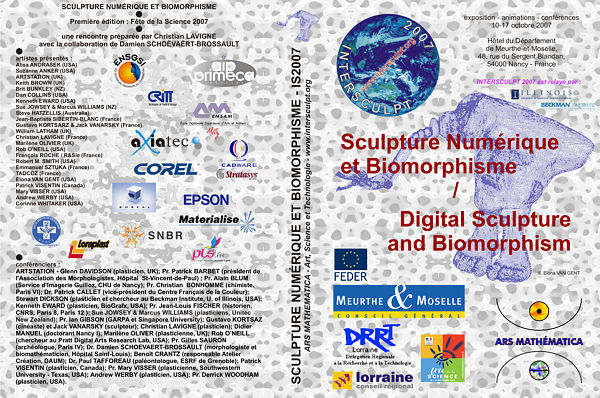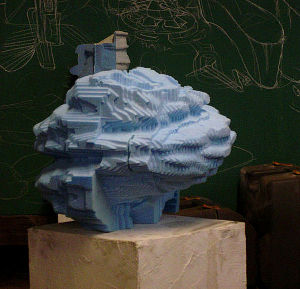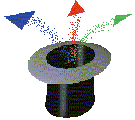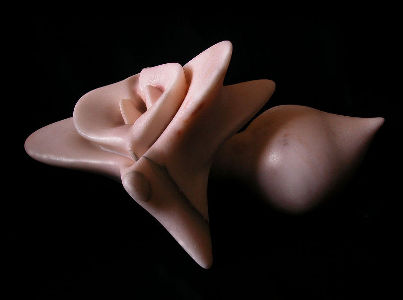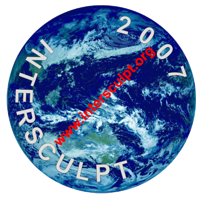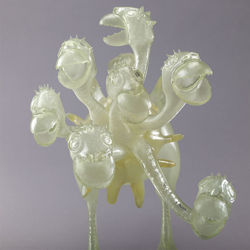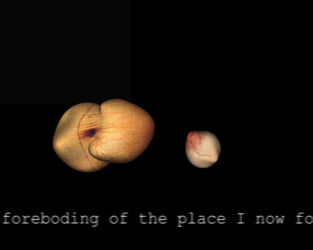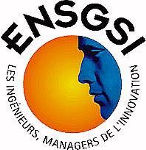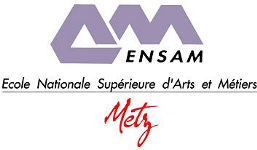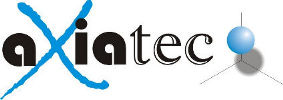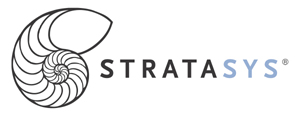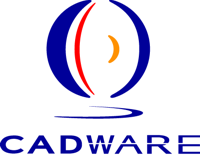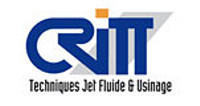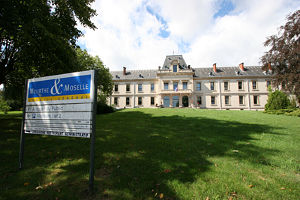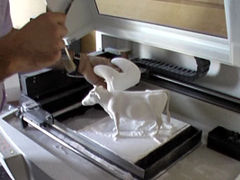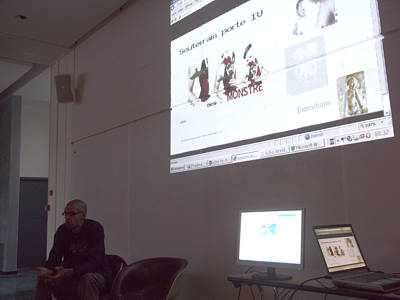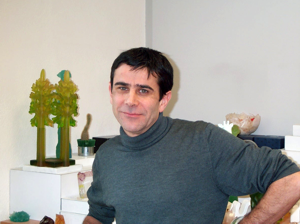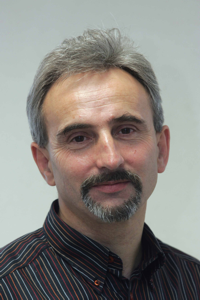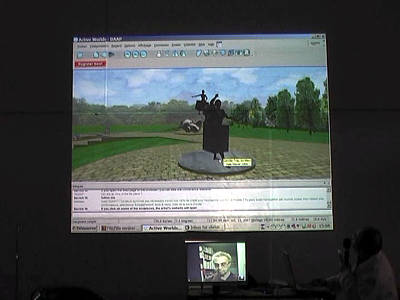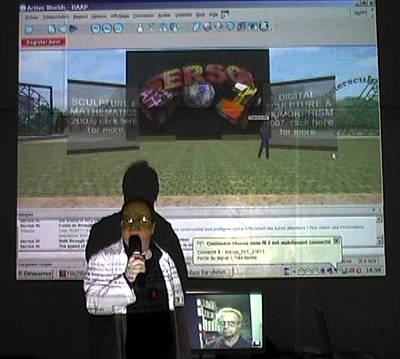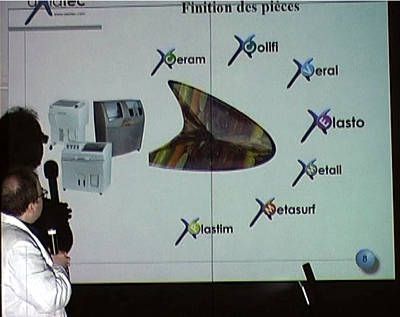MERCREDI
10 OCTOBRE |
CONFERENCIER
/ SPEAKER |
PHOTO
ou/or ILLUSTRATION |
TITRE & RESUME / TITLE
AND ABSTRACT |
| 16H00-16H05 |
Christian
LAVIGNE
cybersculpteur,
co-fondateur D'ARS MATHEMATICA,
d'INTERSCULPT |
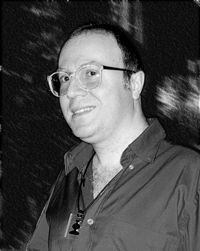 |
Brève
introduction au symposium |
| 16H05-16H35 |
Didier MANUEL
doctorant, philosophe, organisateur de l'International Body Art
Festival 2007 à Nancy |
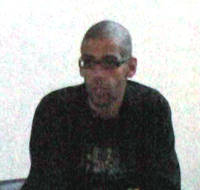 |
"Le corps
Monstrueux dans l'imaginaire contemporain"
|
| 16H35-17H |
Marilène OLIVER
(videoconference)
graveuse,
photographe et plasticienne, enseignante au Royal College of
Art, GB |
 |
"Resurrecting
the digitized body: the use of the 'scanned in' body for making
artworks."
This paper focuses on the scanning
technologies of MRI, CT and PET scanning explaining how and why I use
them to create artworks. The paper concentrates on three works, each of
which has been inspired by and made from scans; Family
Portrait (a series of sculptures made from MRI scans) Dervish (a
sculpture made from CT scans) and Radiant (a sculpture made from PET
scans). As well as focusing on my art practice and the primary
experience of working with DICOM (Digital Imaging and Communications in
Medicine) data, I draw on recent experience of shadowing radiographers
at the Paul Strickland Scanner Centre (PSSC).
|
| 17H00-17H30 |
Rob O'NEILL
Digital
Arts Research Laboratory, Pratt Institute, USA |

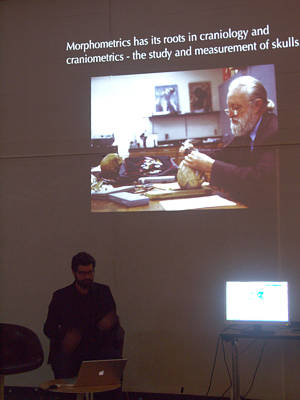 |
"The
Art and Science
of Morphometrics"
Morphometrics is the measurement of shape. It
is usually employed in the comparison of biological structures based on
known homologous anatomical landmarks. The methodological descendent of
anthropometry and craniometrics, morphometrics has incorporated
biometry and biomathematics to become a rival to genomic analysis with
regard to uncovering meaningful evolutionary relationships between
species. Recently, this work has become predominantly
three-dimensional, with data collected physically through Microscribe
object digitizers and virtually via laser-scanning and software
replacing calipers and custom measuring instruments. The digitization
of this work allows for more data sharing, even open-source data
collection, and more advance analysis methods, all leading to more
complex observations and a quantitative mathematical compliment to the
gross observations inherent in the fields of anatomy and paleontology.
Artists like myself can also use this data as a medium with which to
see and represent the world. For the past year I have been developing
tools and experiments on morphometric data that have led to gallery
pieces, tools for scientists, and potentially new morphometric methods.
The Morphology Project experiments range from analysis plug-ins for
off-the-shelf and custom animation software to cinematic
visualizations, all in an attempt to shed light on the processes of
species (including human) evolution, scientific analysis, and natural
history from a hybrid artistic and scientific point of view. These
experiments have included: “The Theory of
Transformations”, a reinterpretation of the historic species
morphing theories of D’Arcy Wentworth Thompson;
“dataProjections”, graffiti style images derived
from capturing the scientists gesture in data collection; and
“dataFace”, a project that attempts to turn a large
historic craniometric database into a means of visualizing the subjects
studied and the human population as a whole. Artists have
always had a critical role in the description and communication of
species information, this project is an attempt to reinvent the way
scientific data is visualized and analyzed.
http://www.morphometric.com/morphology
|
| 17H30-18H00 |
Jean-Baptiste
SIBERTIN-BLANC
designer et
directeur artistique,
Benoît
CRANTZ
ingénieur,
Société
DAUM |
|
"Fleur Envolée: la
création numérique au service de la verrerie
d'art chez DAUM"
|
| 18H00-18H30 |
Pr.
Robert M. SMITH
(videoconference)
sculpteur et
professeur au
New York
Institute of Technology
>
conf annulée |
 |
"Robert Michael Smith: Recent
Work - Focus on Digital Stone" |
|
SAMEDI
13 OCTOBRE |
|
|
|
| 14H15-14H25 |
Christian LAVIGNE
Pr. Derrick WOODHAM |

|
Présentation
générale de l'événement
Présentation du Parc de Sculptures virtuelles
DAAP zone sur ActiveWorlds, crée par D. WOODHAM
|
| 14H25-14H55 |
Dr. Damien
SCHOEVAERT-BROSSAULT
morphologiste
et
biomathématicien, chercheur au Laboratoire de Biologie
Andrologique de la Procréation de l'Université
Paris-Sud et à l'Institut Universitaire
d'Hématologie de l'Hopital Saint Louis à Paris |
 |
"Morphogenèse
et métamorphose : de la forme de
vie à la vie de la forme"
Les formes de l’univers, viennent
toutes de mouvements contraints, de collisions de forces contraires.
Elles sont l’expression de l’équilibre
dynamique d’une ambivalence. Les formes de vie
n’échappent pas aux lois conflictuelles de la
force, mais elles s’en distinguent par leur
capacité exceptionnelle à créer de
nouveaux champs de stabilité
(autopoïèse), et à les entretenir de
façon autonome. Le vivant n’est donc pas le
produit d’instructions inscrites dans les
gènes, mais l’expression de la dynamique
d’interactions complexes. Leur
développement (ontogénèse),
à partir de champs morphogénétiques,
met en jeu des centres organisateurs contenant des opposés
(attraction/répulsion, activation/inhibition). Une
« contrariété productive »
qui assure la stabilité mais aussi
l’émergence de nouvelles structures
(métamorphose). Ainsi les perturbations permettent au vivant
non seulement de se renforcer, par compensation, mais aussi
d’acquérir des propriétés
nouvelles. En augmentant son autonomie, le vivant étend son
champ de stabilité, et donc sa résistance aux
fluctuations du réel.
L’imagination est certainement la faculté la plus
originale du vivant. Non seulement elle nous libère des
contingences, mais aussi elle cerne le réel en lui donnant
forme. Car en réalité, le monde est un tout
où tout se tient, et il n’y a que notre imaginaire
pour le diviser en choses utiles et nécessaires.
L’imaginaire est l’espace de la vie de la forme. Il
est créateur d’innovations
déconcertantes qui nous posent question et nous
transforment. Ainsi, en créant de nouveaux champs
morphogénétiques, dans le registre de
l’imaginaire, artistes et scientifiques nous invitent
à l’accomplissement de l’universelle
métamorphose…

|
| 14H55-15H25 |
Dr. Paul TAFFOREAU
ESRF
de Grenoble, Installation européenne de Rayonnement
Synchrotron |
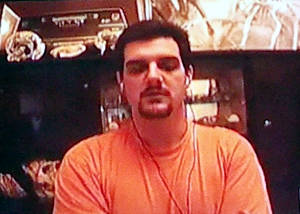 |
"Les
secrets des fossiles révélés par la
lumière synchrotron"
Après plus de deux
siècles d’études scientifiques, les
fossiles ont encore beaucoup de secrets à livrer. Dans de
nombreux cas, les études de morphologie externe
s’avèrent insuffisantes. les caractères
internes doivent être pris en compte pour comprendre un
organisme fossile dans son ensemble.
La technique la plus simple (et la moins chère) consiste
à donner un coup de marteau ou à scier le fossile
en deux pour aller en voir l’intérieur. Elle
présente cependant un inconvénient de taille : le
fossile est partiellement ou totalement détruit. De nombreux
fossiles sont des pièces rares voire uniques. Ils
représentent le seul témoignage de
l’évolution de la vie sur notre
planète. Ils constituent un véritable patrimoine
non renouvelable pour l’humanité. Il est donc tout
aussi important de les étudier que de les
préserver.
Les paléontologues utilisent de nombreuses techniques
– avec plus ou moins de succès – pour
étudier l’intérieur de leurs
spécimens sans les détruire. Depuis quelques
années, à travers les travaux
réalisés à l’ ESRF,
l’imagerie à rayonnement synchrotron
s’impose comme l’outil de
référence pour l’étude
non-destructive des fossiles.
A travers divers exemples, j’essaierai de
démontrer qu’à l’ESRF il est
possible d’obtenir autant, sinon plus d’information
qu’avec un marteau ou une scie. Le seul détail, en
dehors de la taille et du prix de l’outil utilisé,
est que dans ce cas le fossile ressort intact de
l’opération…

|
| 15H25-15H55 |
Pr. Gilles SAURON
professeur
d'archéologie Romaine à
l'Université Paris IV – Sorbonne |
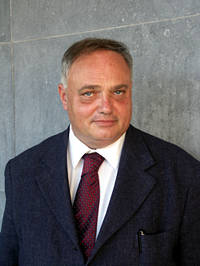 |
"La
mode des
monstres à la fin de la République romaine"
On observe, dans l’art ornemental
romain contemporain des guerres civiles à Rome, au Ier
siècle avant J.-C., une extraordinaire
prolifération de monstres. Il ne s’agissait
nullement d’un prolongement de l’iconographie
traditionnelle que l’art grec avait
développée depuis des siècles sur ce
thème. Un analyse détaillée de ces
décors montre qu’il s’agissait
d’évoquer le chaos originel, la
première naissance du monde, dans un contexte où
de nombreuses prophéties annonçaient ce que les
Grecs appelaient la « transformation de l’univers
» (metacosmesis) et les Romains la «
rénovation du monde » (renouatio mundi). Les
protestations vigoureuses du poète Lucrèce contre
cette mode, au nom de la physique épicurienne,
répondent au succès qu’elle eut
auprès des milieux intéressés
à la « révolution romaine ».
 |
| 15H55-16H25 |
Pr. Patrick BARBET
Docteur
en Médecine, Docteur en Biologie Humaine, Docteur
ès-Sciences Naturelles, Embryologiste Anatomopathologiste,
Médecin Légiste Professeur à la
Faculté de
Médecine Paris 5, Président de l'Association des
Morphologistes Secrétaire de l'IFAA (International
Federation of
the Association of Anatomistes) |
 |
"L'embryon
humain dans l'oeuvre d'un
anatomiste baroque, Frédéric RUYSCH"
Frédéric Ruysch professa
avec beaucoup d’éclat l’Anatomie et la
Botanique à Amsterdam de 1665 jusqu’à
sa mort en 1731. Il y développa tout
particulièrement les techniques d’injection et sa
notoriété le conduisit à recevoir de
très nombreux visiteurs, dont Pierre le Grand qui fit en
1717 l’acquisition du cabinet de curiosités riche
en pièces anatomiques. Certaines de ces pièces
sont aujourd’hui encore exposées au grand public
à la Kunstkamera de Saint Pétersbourg.
Deux sources principales de documents écrits
témoignent directement de
l’intérêt que Ruysch a porté
à l’étude du développement :
le catalogus rariorum in Museo Ruyschiano, publié en 1691
ainsi que les dix volumes du Thesaurus Anatomicus. L’ensemble
permet d’apprécier la qualité des
présentations faites par Ruysch, pour qui tout reposait sur
la qualité de l’observation personnelle :
« Vene, vidi et judica nil tuis oculis ». Le
même souci de vérité et de
qualité a été porté aux
représentations, que le graveur Huyberts « ad
vivium sculpsit ».
A côté des pièces majeures de
l’œuvre de Ruysch, parmi lesquelles ses
célébrissimes compositions de squelettes
fœtaux, sont présentées dans le
Thesaurus Anatomicus des pièces anatomiques correspondant
à une vingtaine de produits de conception,
d’embryons et de fœtus humains. La description
comme l’illustration en sont très
précises et permettent de conclure que Ruysch a eu
l’occasion d’observer et
d’étudier avec minutie non seulement quelques
stades correspondant à la période de croissance
fœtale mais aussi quelques aussi quelques œufs plus
précoces, correspondant à la période
embryonnaire telle que nous la concevons
aujourd’hui. La
présence dans l’œuvre de Ruysch de ces
répresentations particulièrement
précises de stades très précoces du
développement humain est un autre exemple des dimensions
scientifique et artistique exceptionnelles de ses observations, bien
avant la publication « révolutionnaire »
des icones du développement par Soemmering en 1799.
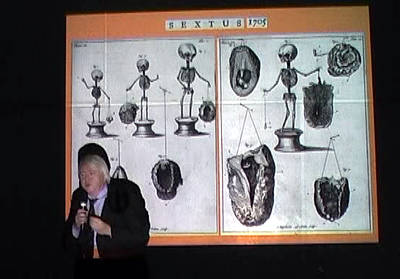
|
| 16H25-16H35 |
PAUSE / BREAK |
|
|
| 16H35-17H05 |
Pr. Ian GIBSON
(videoconference)
The
National University of Singapor |
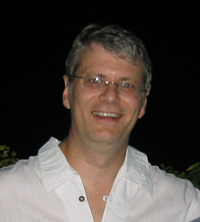 |
"The
use of generative CAD for
creating digital
sculptures"
The authors have been investigating the use of
a CAD utility called GenoForm for creating artistic forms. GenoForm was
used to assist industrial designers in creating variable forms based on
a set of design constraints. For example, a mobile phone must have a
screen, buttons, etc., but this still permits many external forms to be
created around these constraints. The software uses a function that
generates 'creative' forms by adjusting the dimensions and positions of
control points on a freeform surface. If a basic form is given, it is
possible that many related forms can be generated. Until now, this
software has not been tested for artistic forms. This presentation will
discuss the findings.
|
| 17H05-17H35 |
Pr. Christian BONHOMME
Enseignant-chercheur
au laboratoire de Chimie de la Matière
Condensée de Paris VI - Pierre et Marie Curie |
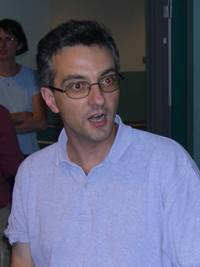 |
"Solid
State NMR Concepts and
Mathematical Representation of Natural Shapes"
This presentation is devoted to the
geometrical representation of solid state NMR concepts leading to the
generalization of quadrics and quartics in this particular frame. Two
dimensional experiments can be illustrated by correlations of such
quadrics and quartics leading to the easy representation ….
of natural shapes! Such an approach is very efficient and shares some
common concepts with the Superformula proposed recently by Gielis.
Various examples using this Superformula will be presented as well.
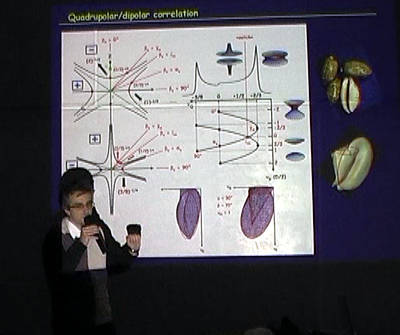 |
| 17H35-18H05 |
Kenneth EWARD
BioGrafx, Scientific
& Medical Images, USA |
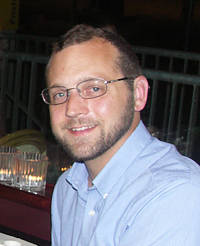 |
"The
Scholars’ Object in a Technological Era: Mementos from the
Molecular World"
A bulwark of traditional Chinese naturalistic
artwork, scholars' objects represented an early use of the found
object. In this art form stones and other natural media were selected
for their likeness to aspects of nature removed in both scale and
place. This likeness was often enhanced through subtle reshaping by the
artist so that a small rock could, for example, be made to represent a
tall mountain or a broad landscape. The found object has been
rediscovered in more recent Western art forms, but the focus has
shifted away from nature toward the products of a technologically
developed society. The sculpture series Intangibles embodies
much of the spirit of the eponymous Eastern art form, also drawing
inspiration from the Western tradition of empiricism. It marks a return
the exploration of natural forms, but on a scale made accessible only
through the agency of modern technology: that of atoms and
molecules. Although molecules are less familiar than the macroscopic
forms of nature that have given rise to much of our artistic heritage,
they are no less a legitimate source of artistic inspiration. Moreover,
the obscurity of macromolecules prior to the late Twentieth Century has
preserved their unique patterns for the present day, presenting an
entirely new field to be cultivated by the artist's imagination.
 |
| 18H05-18H35 |
Dr. Patrick CALLET
enseignant-chercheur
à l'Ecole Centrale de Paris,
vice-président du Centre Français de la Couleur |
 |
"Du
coquillage au papillon: la restitution informatique des couleurs
interférentielles"

|
| 18H35-19H05 |
Patrick VISENTIN
artiste
plasticien et enseignant, Québec |
 |
"Imagining
Science"
Science
is at best
an approximation of what reality is. It affords us
a
probability of reality, given the facts that we know and our ability to
measure and describe. Art allows us to extrapolate on these
facts
and fact based theories and notions and reach beyond what we can
measure and describe. It is able to materialize the unknown improbable
fantastical side of life. The work that I will be presenting
is
just such an extrapolation. A fictitious Phylum of organisms
,
conjures of my imagination inspired by the natural world that owe their
final structure in part from principles articulated in the scientific
world such as symmetry, subunit structure and proportionate scale.

|
|
DIMANCHE
14 OCTOBRE |
|
|
|
| 14H00-14H30 |
ARTSTATION
Glenn
DAVIDSON
&
Anne HAYES
sculpteurs,
GB |
 |
"The Human
CAD CAM”
Artstation
- Artists Anne Hayes and Glenn Davidson have worked together for near
three decades and produced a large body of public work.
They
formed the vanguard of artists who began using computer as a medium for
art in Wales during the mid 1980s, and developing their own topological
software as fellows of Amsterdam University. Artstation’s
highly conceptual and process based work manifests its self as
large-scale architectural and monumental installations. These public
commissions evolve through a “conversation phase”
(from cybernetics Prof. G. Pask - Conversation Theory) and owe much to
the biomophism of numeric topology. These are socially engaged works
built out of geographic qualities and an extended concept of the Genus
Loci (qualities that turn space into place). Recent works promote
“Revitalisation” as a key generator within notions
of Sustainable Development.
 |
| 14H30-15H00 |
Pr. Sue JOWSEY
et
Pr.
Marcus WILLIAMS
UNITEC,
Auckland, NZ |
 |
"Human
communication, biomorphisme and the hyperreal"
To
what degree can Limbic Resonance occur in a social environment highly
augmented by the hyper real?
Using
‘Digital Sculpture as an analogy for the hyperreal, Marcus
Williams will discuss the limbic human dimension (that part of the
brain which facilitates the uniquely mammalian capacity for emotion)
under highly mediated conditions.

|
| 15H00-15H30 |
Dr. Jean-Louis FISCHER
Docteur
d’Etat ès Lettres et Sciences humaines, et
Docteur en Histoire des Sciences, membre correspondant de
l’Académie internationale d’Histoire des
Sciences, chercheur au CNRS (Centre Alexandre Koyré),
chargé de cours à
l’Université de Paris VIII |
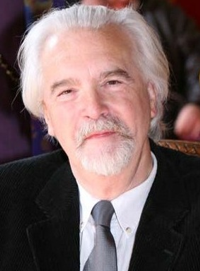 |
"Les
représentations de l’embryon et du fœtus
humains : entre science et art"
Nous évoquerons dans cette
conférence des constructions de discours possibles
concernant des représentations de l’embryon et du
fœtus humains dans la normalité,
l’anormalité et l’imaginaire, en nous
appuyant sur des modèles historiques : hauts reliefs et bas
reliefs (10e/12e s.) du site d’Angkor, des gravures des 16e
et 17e s., des cires des 18e et 19e s., des planches gravées
du 19e s., des gravures et sculptures d’artistes du 20e s.
(quelques dessins et sculptures de Trémois)…
Au-delà de l’esthétisme qui
caractérise ces représentations nous
découvrons une symbolique de l’objet
caractérisant aussi bien l’irrationnelle
imaginaire d’une pensée culturelle,
sociétale, théologique … que la
rationalité d’une pensée scientifique
s’appuyant sur des extrapolations tirées
d’observations réelles… parfois aussi
imaginaire et réalités se
mêlent…
 |
| 15H30-16H00 |
Pr. Alain BLUM
Service
d'Imagerie Guilloz, CHU de Nancy |
 |
"Imagerie
médicale: une nouvelle vision de l'Homme"
 |
| 16H00-16H30 |
Christian LAVIGNE
cybersculpteur
Gilles
RAFFIER
société
AXIATEC |

|
"MNEMOSYNE, et
autres exemples d'Impression 3D couleur au service de l'art"
Christian LAVIGNE, pionnier de la sculpture
numérique, s'intéresse depuis plusieurs
années aux nouvelles possibilité de la
fabrication d'oeuvres polychromes grâce à la game
d'Imprimantes 3D couleur Zcorp, mise au point en 1999-2000 et
lancée en 2001. Après avoir
réalisé les toutes premières
cybersculptures en couleurs photographiques grâce
à la société américaine
(les premiers essais artistiques en aplats de couleurs ont
été fait par notre ami Stewart DICKSON),
l'artiste a pu grandement améliorer ses productions
grâce aux recherches de la société
française AXIATEC, dirigée par Gilles
RAFFIER, qui vient de déposer un brevet pour le
procédé couleur haute résolution
ColHiFi. Ce procédé est actuellement unique au
monde par sa qualité.
La toute dernière création, en cours, de
Christian LAVIGNE, est TETE A TETE 2 / MNEMOSYNE. Elle part d'un
scanner médical 3D du crâne de l'artiste,
réalisé grâce à
l'équipe du Pr. Alain BLUM du CHU de Nancy, crâne
dont le fichier sera transformé par l'adjonction d'un
mapping d'images de la vie de l'artiste, et finalement
rematérialisé.
Au delà de cet exemple spectaculaire, Gilles RAFFIER
présentera les usages potentiels de l'Impression
3D couleur au service de l'art et du design.

|
| 16H30-17H00 |
Andrew WERBY
sculpteur,
USA |
 |
"The
Extension of Juxtamorphic Art in Response to the Expansion
of Cybernetic Technology"
Juxtamorphic
art is a system of 3-dimensional assemblage originated by California
sculptor Andrew Werby which uses natural forms and textures as basic
units. Originally based on surface information captured using molds
combined and replicated by manual modeling and casting, it has lately
been empowered by the use of 3d scanners, CAD software, CNC milling and
Rapid Prototyping techniques to encompass a wider range of sources and
provide more freedom in utilizing them. Applications include sculpture
in relief and in the round, ceramics and jewelry. This presentation
traces the progress of Juxtamorphism from its origin to its most recent
manifestations.
 |
| 17H00-17H30 |
Pr. Mary VISSER
Southwestern
University, Texas, USA |
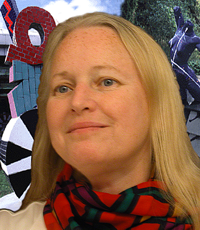 |
"The Internal/External:
A Metaphor for the Visual Space of the
mind of the artist"
Although
Cartesianism in epistemology has been challenged by many philosophers,
the “thesis that the subject’s own consciousness
and its contents are known to the subject in a special, intimate and
secure way” (H. Malmgren) is a fact for me as an artist.
These theories interests me with regard to the visual space of the
artist’s mind particularly as it pertains to the creation of
works of art. For it is in the mind that my work starts and
the computer as a tool has been the only tool I’ve found that
can replicate exactly what I see within my mind. When working in other
mediums my vision has always been subjugated to the characteristics and
limited by the processes of the medium. In the book from the
exhibition of the same name “Made Known” the writer
and artist Ian Gwilt points out that the computer has given the artist
the ability to make known the actual images of the mind that could not
otherwise have been constructed for the real world. It is
this visualization and actualization of the process of interpreting the
organic nature of the mind that I find intriguing about using software
and point data to make known my intimate content to others.
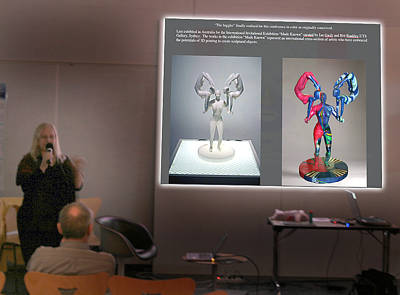 |
| 17H30-18H00 |
Gustavo KORTSARZ
plasticien
Jack VANARSKY
sculpteur |
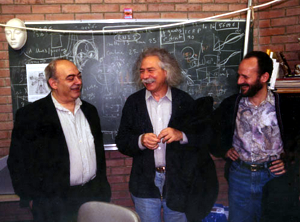 |
"Toporgraphie"
Film d'animation conçu à
partir du portrait de Roland Topor.
Le scénario de ce film est inspiré d'un fantasme
de Jack
Vanarsky, dans lequel les lamelles qu'il utilise pour la
réalisation de ses sculptures animées se
mélangent.
Ce film utilise les techniques d'animation 2D et 3D, qui ont permis
à Gustavo Kortsarz d'animer le portrait de Topor en
s'inspirant
du mouvement des sculptures de Vanarsky.
Ce portrait se fonde sur l'analyse du visage de Topor par un scanner 3D.
Les données du scanner ont été
utilisées :
- Pour la réalisation du film en images de
synthèse ;
- Pour la réalisation de la sculpture de Jack Vanarsky qui a
travaillé à partir du tracé des
tranches du visage
de Topor obtenues par la scannérisation.
Le mouvement des sculptures de Vanarsky est produit par un moteur qui
reste généralement caché. Le bruit
produit par le
mécanisme n'est pas dissimulé, c'est une
émanation
indissociable de la sculpture, comme une voix...
C’est cette matière sonore qui est à la
base de
l'élaboration de la bande son du film,
réalisée
par le musicien Garth Knox.
Vanarsky a déjà traité le
portrait par
lamellisation d'images fixes, et le masque par l'animation de
sculptures. Depuis longtemps, il désirait
réaliser une
oeuvre dont les dessins des profils proviendraient de l'analyse du
modèle par ordinateur. Ce désir a
été le
point de départ de la collaboration de Jack Vanarsky et de
Gustavo Kortsarz, pour la réalisation de ce film.
 |
| 18H00-18h30 |
Paul
HIGHAM
(videoconference)
sculpteur,
USA
>
conf annulée pour des raisons techniques |
 |
"knowledge is power"
Autotecture Fugue...real- time Synthetic Datasculpture with neural gas algorithm and mined data.
|
| 18H30-19H00 |
Alisa
ANDRASEK
(videoconference)
architecte,
Cabinet BIOTHING, USA
>
conf annulée pour des raisons techniques |
 |
"Biothing:
a digital architecture lab"
Biothing
is a research-design laboratory directed by Alisa Andrasek, an
experimental practitioner of architecture. Founded in 2001, Biothing's
research focuses on the generative potential of physical and artificial
computational systems for design. Biothing attempts to engage with
complexity through an algorithmic articulation of the relation between
the corporeal and incorporeal. In their work, design is understood as
genetic inscription. |
|
|
|
|

